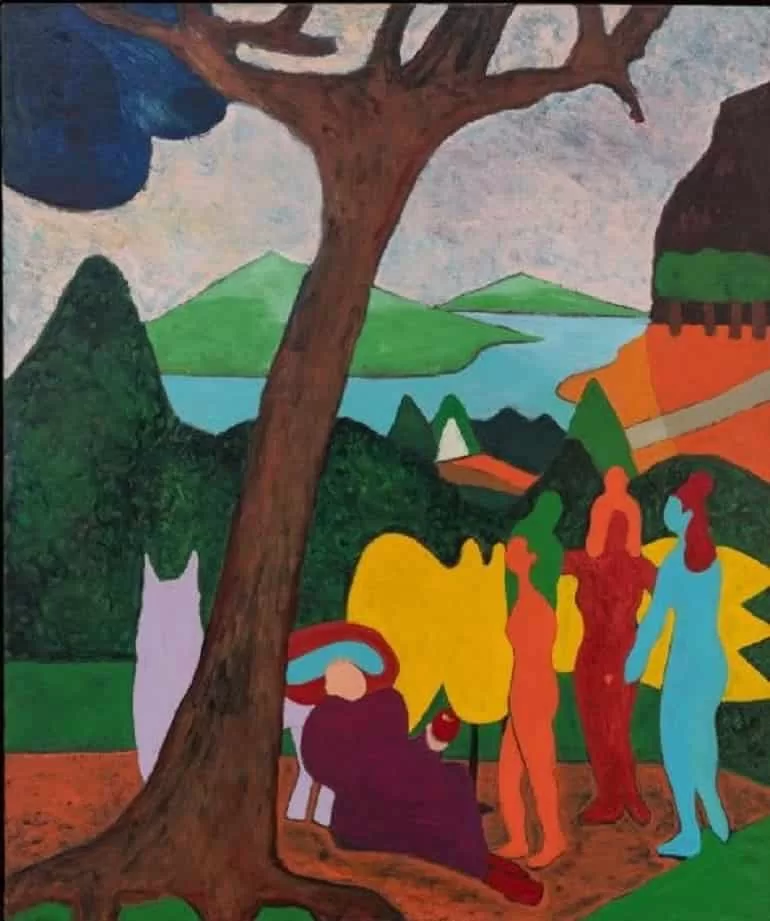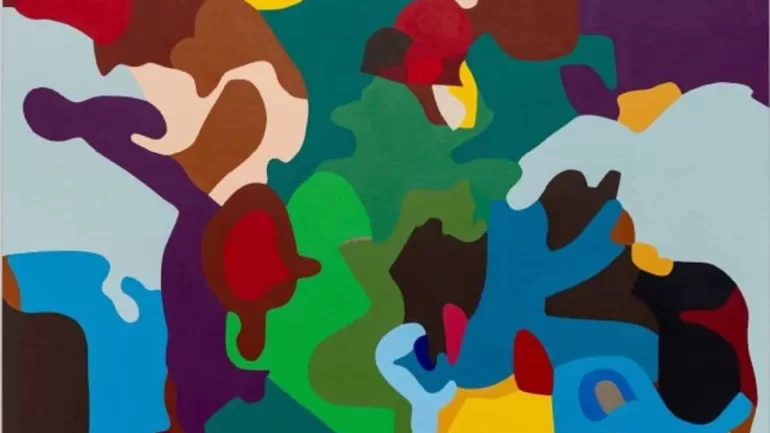ART & DESIGN
cbob 1, an abstract painting by artist Candida Alvarez in the Real Monsters in Bold Colors. Image: GRAY
Real Monsters in Bold Colors at GRAY reveals the dynamic interplay of history, color, and narrative in works by Thompson and Alvarez.
BY KAZEEM ADELEKE, ARTCENTRON
The exhibition Real Monsters in Bold Colors at GRAY Gallery is a compelling dialogue between two influential artists: Bob Thompson and Candida Álvarez. It places Thompson’s reinterpretations of Old Master paintings alongside Álvarez’s vibrant abstractions. This juxtaposition highlights their shared commitment to exploring color, form, and cultural narratives.
Bob Thompson: Reimagining the Old Masters
Bob Thompson (1937–1966) was an African American painter who merged elements of Baroque and Renaissance art with the energy of Abstract Expressionism. Despite a brief career, he created more than a thousand works. He drew inspiration from masters like Piero della Francesca, Francisco Goya, and Nicolas Poussin. His paintings often featured flattened forms and vivid colors. These elements echoed his immense affinity for jazz and its improvisational nature.
Thompson’s work is known for its expressive silhouettes, rhythmic structures, and bold chromatic intensity. These qualities reflected his profound connection to jazz and the spontaneity of improvisation. He developed a striking visual language that challenged the Western canon. He did this by placing Black bodies in allegorical, mythic, and spiritual contexts long denied to them. In doing so, Thompson reclaimed and reimagined art history. He emerged as a pioneer of narrative expression during a period dominated by abstraction.
GRAY Gallery recognized Thompson early on. He was featured in its inaugural exhibition in 1963 and had a solo show in 1964. These exhibitions underscored his importance even during his short lifetime. Today, his legacy endures in major institutions. These include the Whitney Museum, the Smithsonian American Art Museum, and the Studio Museum in Harlem.
The Real Monsters in Bold Colors

Candida Álvarez: Color as Memory, Story, and Resistance
Candida Álvarez (b. 1955) is a painter whose work blends abstraction with personal and cultural narratives. Born in Brooklyn to Puerto Rican parents, Álvarez’s art reflects her heritage and experiences. Her compositions have vibrant colors and layers of textures, often incorporating elements of textile aesthetics, music, and language.
In this exhibition, Álvarez’s new works engage directly with Thompson’s compositions. She draws inspiration from his bold distortions and fearless use of color. “Thompson gave me the courage to push that relationship,” Álvarez says. Her dynamic paintings inhabit the space between abstraction and figuration. She transforms bodies into color fields and renders memories into textured surfaces.
Álvarez has charted an influential path. She began with early exhibitions at El Museo del Barrio and artist residencies at the Studio Museum in Harlem. She later became a long-standing educator at the School of the Art Institute of Chicago. Her impact extends beyond her practice to generations of painters she has mentored. Her artworks are held in prestigious collections, including the Art Institute of Chicago, the Whitney Museum, the Pérez Art Museum Miami, and the Museum of Contemporary Art Chicago.
A Fusion of Influences: Painting as Reimagined Language
Both Thompson and Álvarez create within a matrix of art historical resonance and personal narrative. Their works challenge and expand the boundaries of figuration and abstraction. Thompson’s reinterpretations of European masterpieces, infused with African American experiences, laid the foundation for Álvarez’s inquiries. She explores identity and memory through vibrant color and abstract form.
The exhibition highlights painting as a method of translation and liberation. For Thompson, the process involved transforming the weight of European art. He reimagined it into something new—American, Black, and rhythmic. For Álvarez, Thompson’s radical approach offers permission. It encourages her to blur the boundaries between figuration and abstraction. She infuses emotional memory into form.
Álvarez’s paintings do more than respond to Thompson’s legacy. They expand it. Her work deepens the expressive power of color. She redefines figuration as a fluid and inclusive gesture.
The Power of Color as Storytelling
The title Real Monsters in Bold Colors originates from poet Hettie Jones. A contemporary and friend of Thompson, Jones described the emotional depth of his work. She saw his “monsters” as internal struggles and allegorical figures brought vividly to life in technicolor.
This notion of monstrosity as metaphor, coupled with the artists’ fearless chromatic vocabularies, charges the exhibition with emotional urgency. Thompson’s works frequently depict mysterious figures, angels, satyrs, and masked bodies in surreal landscapes—a blend of fantasy and critique. Meanwhile, Álvarez uses intense color fields and layered textures to evoke memory and cultural presence. Her paintings often incorporate text, shapes, and gestures. As a result, her compositions feel both tactile and dreamlike.
Legacy, Influence, and Artistic Freedom
One of the most powerful throughlines of this exhibition is the honest confrontation with influence. While many artists obscure their references in pursuit of originality, Álvarez is explicit: “Thompson’s work is my liberation. “Why not a pink, red, or brown body frolicking under a tree?” This question reveals her view of art history. She approaches it not as a fixed canon, but as a living and evolving ecosystem of ideas.
Thompson’s bold inclusion of Black figures in classical contexts not only challenged existing norms but also created opportunities for future artists. He enabled them to assert their presence and reshape the narrative landscape of art history. Álvarez takes up this mantle by creating works that are not merely inspired by history but actively rewrite it.
The exhibition includes a richly illustrated catalog. It features an essay by Hendrik Folkerts, Curator of International Contemporary Art at Moderna Museet in Stockholm. Folkerts offers scholarly insight into how Thompson and Álvarez challenge and transcend the dominant narratives of art history. The essay situates both artists within broader transatlantic dialogues around abstraction, color, and representation.
Redefining Art Historical Canons Through Color and Courage
Real Monsters in Bold Colors is more than an exhibition. It stands as a testament to painting’s power as a medium of cultural memory, resistance, and storytelling.
In bringing together the radical visions of Bob Thompson and Candida Alvarez, Gray opens a space of history. The gallery offers a space for the preservation of history and reimagination through bold chromatic vocabularies and fearless experimentation.
This exhibition urges viewers to look back to move forward. It celebrates the embrace of influence as a path to new expression. It invites artists to take space with an unapologetic presence. For those who value contemporary painting, historical depth, and the emotive force of color, Real Monsters in Bold Colors is a vital encounter.
